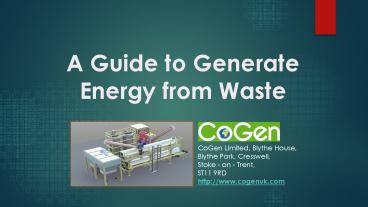A Guide to Know Process of Generating Energy from Waste - PowerPoint PPT Presentation
Title:
A Guide to Know Process of Generating Energy from Waste
Description:
Watch this presentation to know the different kind of processes of generating energy from waste material. This includes conventional as well as advanced conversion technologies. Share your feedback on this presentation. – PowerPoint PPT presentation
Number of Views:67
Title: A Guide to Know Process of Generating Energy from Waste
1
A Guide to Generate Energy from Waste
CoGen Limited, Blythe House,Blythe Park,
Cresswell,Stoke - on - Trent,ST11
9RD http//www.cogenuk.com
2
Overview
- Recovering energy from waste is only appropriate
for waste that cannot be prevented, reused or
recycled with less greenhouse gas emitted. - Energy recovery can be a sustainable option for
waste that would otherwise go to landfill and
create landfill methane emissions.
3
Conventional Technologies
- Direct combustion (incineration) of dry biomass
- The heat generated by the following wastes can be
used directly to warm homes and buildings or to
generate electricity using a steam turbine, or
both, through combined heat and power systems - direct combustion (incineration) of dry biomass
waste such as wood waste, straw and poultry
litter - the biomass part of municipal waste
- some commercial and industrial wastes
- some construction and demolition wastes
4
Combustion of Waste-Derived Fuel
- The methane produced from landfill (landfill gas)
is a waste-derived fuel. It can be used in the
same way as for combustion plants or it can be
injected into the national gas grid. Waste
derived fuel is also referred to as Solid
Recovered Fuel (SRF) or Refuse Derived Fuel (RDF).
5
Anaerobic Digestion
- Anaerobic digestion (AD) is a natural process in
which micro-organisms break down the organic
matter found in wet biomass waste (such as sewage
sludge, animal manure and slurry and waste food)
in the absence of oxygen, to produce biogas
(mainly a mixture of around 60 methane and 40
carbon dioxide) and digestate (a nitrogen rich
fertiliser).
6
Advanced conversion technologies
- Gasification Gasification is a type of advanced
conversion that produces a combustible gas that
is a mixture of carbon monoxide, hydrogen, carbon
dioxide and methane. This gas can be used
directly to generate heat and electricity. - Pyrolysis Pyrolysis is a type of advanced
conversion that can be used to produce either a
combustible gas, oil or solid char (sometimes
known as biocoal). In the future, it will be
possible to upgrade pyrolysis oil to produce
petrol and diesel using oil refining techniques.
7
Environmental Controls
- All energy from waste plants must comply with
regulations concerning environmental protection,
animal by-products, duty of care, health and
safety, waste handling and planning permission.
8
Contact for more information
CoGen Limited, Blythe House,Blythe Park,
Cresswell,Stoke - on - Trent,ST11
9RD http//www.cogenuk.com































